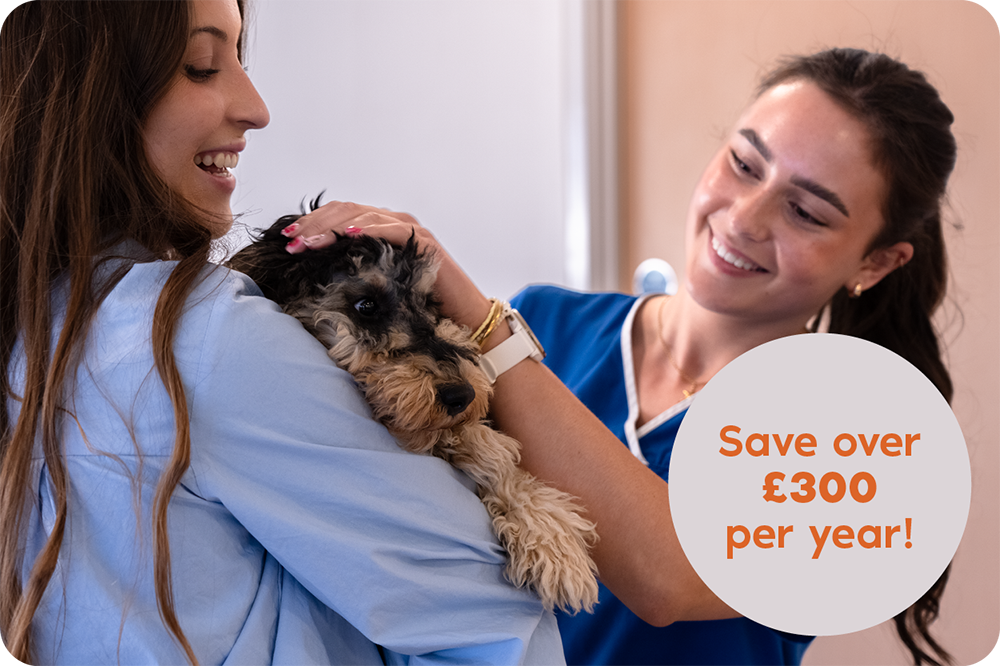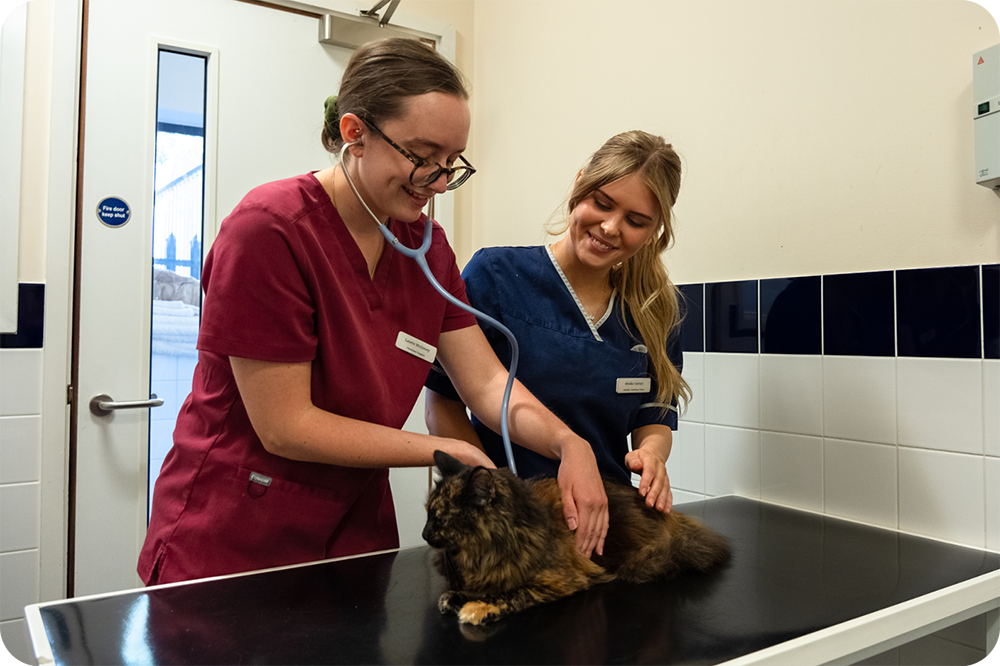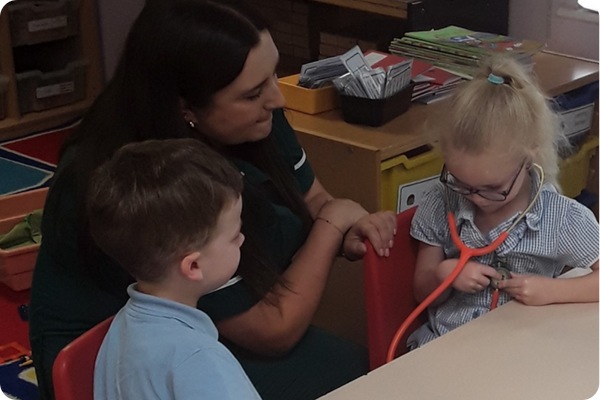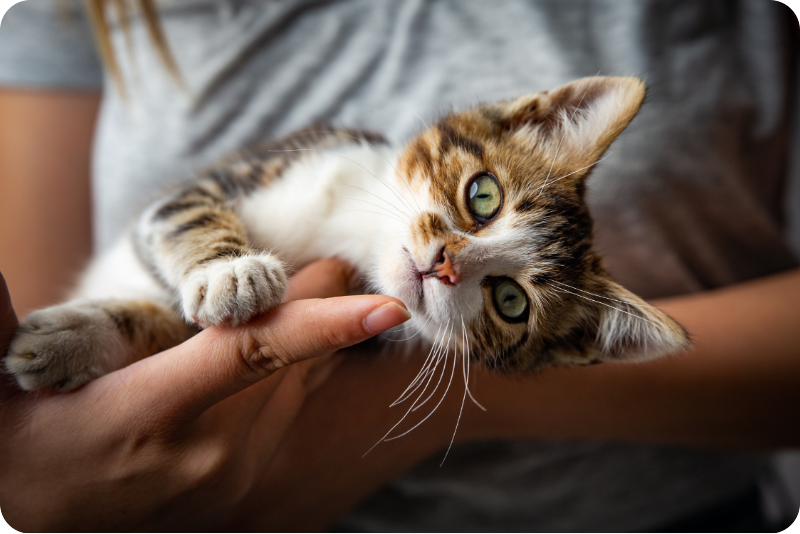”Kidney disease” is a general term for what happens when a cat’s kidneys stop working properly. “Chronic” means that this change happens over a period of time, rather than suddenly.
The kidneys’ job is to filter the blood and remove the natural toxins that are produced by the body every day. When the kidneys stop working properly, this means that those toxins are not all being removed, and can start to build up in the body. These toxins are the cause of many of the symptoms of kidney disease.
There are many different reasons why a cat’s kidneys might start to fail. Often it simply due to old age, but occasionally it can be caused by something else, such as cancer or an auto-immune condition. However, most of the treatments that we use for kidney disease are the same regardless of the underlying cause.
Symptoms of Kidney Disease
There are many different symptoms that can be seen in cats with kidney disease. These include:
| · Drinking more
· Peeing more often · Peeing larger volumes · Eating less, or not at all · Weight loss |
· Vomiting
· Diarrhea · Constipation · Bad breath |
However, most cats do not get all of these symptoms, or at least not all at once. Almost all cats with kidney disease will become more thirsty and pee more often, but the rest of the symptoms can vary.
In the earlier stages of kidney disease, these symptoms usually come and go, rather than being present all the time. Often, cats will go through episodes (which may be a few days or a few weeks) where they feel worse than normal, and experience several of these symptoms. In between these, however, cats may live a relatively normal life.
Some cats may stay in these early stages of kidney disease for some time—years, in many cases. But sadly, kidney disease will almost always get worse over time.
In the later stages of kidney disease, the symptoms may become more persistent. Cats may need daily medication to help relieve nausea, improve appetite, or treat constipation, in order to keep them happy and comfortable.
Treating Kidney Disease
In humans, advanced kidney disease is treated with dialysis, or with a kidney transplant. Sadly, neither of these are options for our cats, and so we cannot restore the kidney function that they have lost. This means our treatment is focused on slowing down the deterioration in their kidney function, and improving their quality of life.
Reducing the Symptoms
Many of the symptoms of kidney disease can be relieved with medication. Milder symptoms can normally be treated at home, but with more severe symptoms, your cat may need to be admitted for treatment at the practice for a time. Here, we can also use intravenous fluid therapy (“a drip”) to try and flush out some of the toxins that build up in your cat’s body.
Sadly, there will likely come a point when we are unable to improve a cat’s quality of life with medication. You may also get to a stage where you feel that the process of treating your cat is affecting their quality of life, and it is in their best interests to continue. At this stage, you may have to make the difficult decision to have your cat put to sleep.
Supporting the Kidneys
While we sadly cannot fix or replace our cats’ kidneys, there are steps we can take make sure that they are under as little strain as possible. This gives our cats the chance to live longer, happier lives. These are some of the things that have been proven to help our cats’ kidneys.
Special Diets
Kidney diets are designed to be low in the substances that your cats kidneys can no longer filter out, which relieves some of the burden on the kidneys.
These diets are one of the best and most important treatments that we have for kidney disease, both in terms of reducing our cats’ symptoms and in helping them to live longer.
Wet food is probably best for cats with kidney disease, as it has a high moisture content which will help to keep them hydrated. However, it is better for a cat to eat dry kidney food than to eat regular non-kidney food, so you can try it out if needs be.
Like any new food, special kidney diets should be introduced gradually over at least a week. The first day, start by offering your cat a small amount of the new food alongside their old diet—do not mix them, but offer in two separate bowls. They may not eat it at first—that’s fine! Just make sure they have the option. Then over the next week, slowly increase the amount of the new food that you offer, and reduce the amount of old food alongside. By the middle of the week, you should be offering half old food and half new food, in separate bowls. Then, by the end of the week, they should be completely on the new food.
Some cats may not like the kidney diets, and may start eating more slowly or refusing to eat the new food at all. It is always difficult when our pets don’t want to eat, but keep in mind that you’re doing this to try and make them feel better—even if their sad mews are telling you that right now they feel the opposite! There are a few things that you can do to help encourage them to eat:
- If your cat is a fussy eater, it is important to warm the food before offering it, as the smell of a meal is often what makes it interesting to your cat. If you are feeding wet food, you can microwave this gently, but check with your finger to make sure it is not too hot! If you are feeding dry kibble, you can mix a little warm water through the food to make a kind of gravy that may add interest.
- Regular mealtimes can be helpful for some cats. Offer your cat a small, warm dish of wet food, two, three, or even four times a day. You can use the feeding guide on the side of the packet as a starting point for the amount to give them. If they do not eat it within half an hour, take the food away, and then offer them fresh food at their next mealtime.
- Be sure to offer your cat privacy while the food is available—cats usually prefer to eat alone, away from other cats or humans. Food bowls should also be kept well away from water bowls or litter trays.
- Try using a few different kinds of kidney diets. Some cats may prefer the taste or texture of one type or another, and it’s find to mix-and-match, as long as all the different diets are designed for cats with kidney disease.
If these tricks are not enough, then do speak to your vet. Feeding a kidney diet is one of the most important things we can do to help slow our cats’ kidney disease and relieve their symptoms, so it is worth persevering.
Encourage Drinking
Cats with kidney disease need to drink more, and will produce larger volumes of urine, too. This is the body’s way of trying to flush out the toxins that the kidneys would normally remove, and is quite normal with kidney disease.
This may mean that the litter tray needs changing more often, but don’t be tempted to restrict your cat’s water – this will just lead to dehydration and will damage the kidneys even more. Making sure that you cat stays well-hydrated will minimize their symptoms.
Make sure that your cat has a choice of several different sources of water available at all times, placed in several different locations round the house. These might be bowls, or water fountains for cats who prefer moving water. Avoid putting water bowls near food bowls, or near litter trays. Both of these can discourage cats from drinking.
You can also get flavored electrolyte drinks that are designed for cats, or other kinds of broth, which may make drinking more interesting to them. However, some of these may not be suitable for cats with kidney disease, speak to your vet for more advice.
Do not give human electrolyte drinks to cats.
Blood Pressure Medication
Cats with chronic kidney disease are prone to developing high blood pressure. This can happen at any stage of kidney disease, and is often “silent”, meaning cats do not show symptoms. However, having high blood pressure for a period of time can cause damage to your cat’s organs, including their retinas (the back of their eyes) and brain. It can also cause their kidney disease to get worse more quickly.
Your vet can measure your cat’s blood pressure during an appointment. If it is normal, then that is reassuring. However, if it is high, we may need to admit your cat to the clinic for a day to allow them to relax and take several readings a few hours apart. This will let us check if they have genuinely high blood pressure, or if it was just as a result of stress in the appointment.
Treating Protein Loss
Some cats will lose protein through their urine as a result of their kidneys disease. This can mean cats lose weight more quickly, and also causes further damage to the kidneys. If significant levels of protein are detected in your cat’s urine, then we will recommend medication to try and stop this from happening.
Phosphate Binders
Phosphate is one of the substances that can build up in your cat’s blood in kidney failure. Your vet can measure the levels of phosphate via a blood test, to determine whether they would benefit from medication to reduce it.
In order to reduce your cat’s blood phosphate levels, we must reduce the amount of phosphate that they are eating. The best way to do this is with the special kidney diets (mentioned above).
However, there are a few cats who will not accept kidney diet. In more advanced kidney disease, these diets may also not be enough to bring our cat’s phosphate levels down to normal. In these situations, we can add a kind of medication called a Phosphate Binder to your cat’s food. These reduce the amount of phosphate that can be absorbed from your cat’s gut.
Monitoring the Kidneys
We recommend that cats with kidney disease have a check-up every three to six months, depending on how advanced their condition is. This allows us to monitor for any changes in their kidney function, and to treat any issues that arise quickly and effectively.
Blood Tests
Regular blood tests allow us to monitor your cat’s kidney function over time. They are also important to look for other issues like anaemia (low red blood cells), electrolyte imbalances, or increasing phosphate levels that may need specific treatment in order to keep your cat’s quality of life as good as possible.
Urine Samples
Cats with kidney disease produce a lot of very dilute urine, which is much easier for bacteria to grow in, and so are prone to developing bladder infections. They may also start losing protein in their urine, which can cause further damage to the kidneys. Regular testing of urine samples is needed to detect infection or high protein levels, as either of these can reduce quality of life and shorten life expectancy if left untreated.
Blood Pressure Checks
Cats with kidney disease are prone to developing high blood pressure, which can cause further damage to the kidneys. Regular monitoring of blood pressure helps us to identify this quickly, and medication can be used to bring the blood pressure back down to normal.
Prognosis
There have been several different studies that have looked at the life expectancy of cats with chronic kidney disease. All the studies agree that their lifespan is likely to be related to how severe the kidney disease it.
Cats with Stage II disease (which is the earliest stage they can reliably be diagnosed) will, on average, live for at least a year after diagnosis—some studies suggest this may be more likely two or three years.
Cats with Stage III disease have an average life expectancy of between 6 months and 18 months.
Cats with Stage IV disease will sadly only usually live for a month or two after diagnosis.
There are also other things that can affect life expectancy, including the presence of protein in the urine, high levels of phosphate in the blood, or low levels of red blood cells (anaemia).
Your vet can let you know what stage your cat’s kidney disease is, which will help you to know what to expect.
If you’re concerned your cat may have kidney disease, or if they’ve already been diagnosed and you need guidance, we’re here to help. Contact your nearest practice today to speak with our caring veterinary team and ensure your cat gets the support they need.
Find a Vet Practice Near You
Our Latest News and Advice

Join our Pet Healthcare Plan, the Kin Care Club.
Our comprehensive pet healthcare plan is designed to help you give your cat or dog the best care, while keeping your budget in mind.
Whether you’re looking for essential coverage or complete peace of mind, the Kin Care Club offers two flexible plans tailored to your needs and your pet’s well-being.




